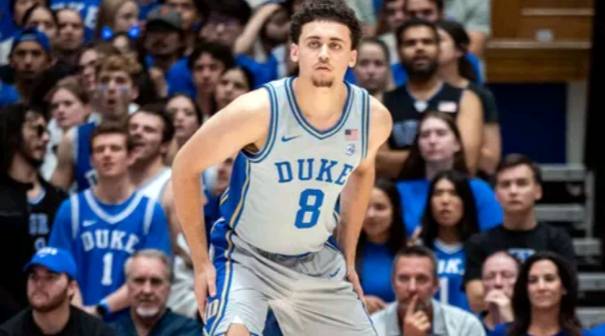
NO Dᴜᴋᴇ Sʜᴀʀᴘꜱʜᴏᴏᴛᴇʀ ɪꜱ ᴍᴀᴋɪɴɢ ᴀ ᴄᴏᴍᴇʙᴀᴄᴋ ꜰᴏʀ ᴛʜᴇ ꜱᴏᴘʜᴏᴍᴏʀᴇ ꜱᴇᴀꜱᴏɴ, ᴛʜᴀɴᴋꜱ ᴛᴏ Dᴀʀʀᴇɴ Hᴀʀʀɪꜱ
The Blue Devils’ lights may have dimmed too early during March Madness this past season, but one beacon still burns bright in Durham: Darren Harris. The 6-foot-6 lefty sharpshooter and McDonald’s All-American is gearing up for a sophomore campaign that promises to reshape Duke’s offensive identity.
Coming off a freshman year that had moments of brilliance overshadowed by an inconsistent role and limited touches, Harris is primed to emerge as the key perimeter weapon for head coach Jon Scheyer. With a revamped roster and a renewed sense of purpose, Duke’s sophomore sensation is not only coming back—he’s coming for the spotlight.
In 2024–25, Darren Harris averaged modest numbers: 6.3 points, 1.8 rebounds, and 0.7 assists per game across 14.2 minutes. But the stat sheet doesn’t tell the full story.
Playing behind the likes of Jeremy Roach, Jared McCain, and Tyrese Proctor, Harris spent his freshman year learning the intricacies of high-level college basketball from the bench. But when his number was called, the Virginia native delivered. He shot a blistering 41.7% from three-point range, often providing a much-needed spark off the bench.
Harris never complained. He never wavered. Instead, he soaked in every moment, understanding that his time was coming.
Now, that time has arrived.
The knock on Harris coming out of Paul VI Catholic High School in Fairfax, Virginia, was that he was a one-dimensional sniper. No one questioned his shooting ability—he was considered the best pure shooter in the 2023 recruiting class—but critics often doubted his defensive presence, playmaking, and physicality.
Harris has taken those critiques personally. In recent interviews, he’s emphasized how he’s “completely transformed” his game over the offseason.
“I’m not just a shooter anymore,” Harris said in an early May workout session. “I’ve been working on my handle, my defense, and finishing through contact. If people think I’m just going to stand in the corner and shoot threes, they’re in for a surprise.”
Sources close to the Duke program say Harris has added 12 pounds of muscle, improved his lateral quickness, and now thrives in transition defense—something Scheyer is prioritizing heading into the 2025–26 season.
Duke will look drastically different this upcoming season. With McCain, Roach, Proctor, and Kyle Filipowski all gone to the NBA or professional ranks, the stage is set for a new generation of Blue Devils to take center court.
Enter Darren Harris.
He’s expected to start at shooting guard, potentially sliding to small forward in three-guard sets. Playing alongside incoming five-star point guard Ace Bailey and highly touted freshman forward Cooper Flagg, Harris has found himself in the ideal situation.
“With so many scorers gone, we need leadership and shot-makers,” Scheyer said in a press conference. “Darren gives us both. He understands the system now. He’s become a vocal leader, and his ability to stretch the floor changes how teams defend us.”
And with Flagg likely to draw double teams in the paint and Bailey commanding attention as a primary ball handler, Harris could feast on open looks from deep.
Jon Scheyer’s offensive philosophy heavily relies on floor spacing, ball movement, and read-and-react principles. It’s a modern system tailored for shooters like Harris.
Unlike traditional motion offenses that bog down in half-court sets, Duke’s scheme emphasizes transition opportunities and corner spacing—two areas where Harris excels.
During the 2024–25 season, Harris led Duke in catch-and-shoot efficiency per 100 possessions, despite limited minutes. According to Synergy Sports, he ranked in the 92nd percentile in spot-up shooting across all NCAA Division I players.
Scheyer knows that kind of weapon cannot be hidden any longer.
“We want to get up and down, we want to play fast, and we need guys who can stretch the floor and make defenses pay,” Scheyer said. “Darren’s going to be a huge part of that.”
Duke’s 2025–26 recruiting class has been labeled as one of the best in the country, headlined by Cooper Flagg, Khaman Maluach, and Ace Bailey. The potential starting lineup will feature at least three underclassmen, and that presents both a challenge and an opportunity.
In the early days of summer workouts, Harris has already emerged as a vocal leader and mentor to the incoming freshmen.
“Coop and Ace are amazing talents,” Harris said. “They’re humble, hard-working, and willing to listen. We’ve already been getting extra reps in, working on timing, where I like the ball, how they see the court. Chemistry is going to be key, and I think we’re way ahead of schedule.”
Teammates and coaches alike have praised Harris for stepping into a leadership role with natural poise. For someone often overshadowed by more heralded recruits, Harris is proving that experience and work ethic matter just as much as five-star rankings.
Harris has also become one of Duke’s most marketable athletes thanks to his combination of clean image, highlight-reel shooting, and personality. This summer, he’s inked new NIL deals with local businesses and national brands alike, including a shoe campaign with Nike specifically highlighting his shooting form.
“It’s great to see the hard work off the court pay off too,” Harris said. “But my focus is on winning. I want to hang a banner.”
Those close to Harris say the financial support has only added fuel to the fire, not distracted from the grind. His social media presence has grown significantly, with many fans now hailing him as “The Lefty Laser” and “Durham’s Deadeye.”
NBA scouts weren’t buzzing about Harris during his freshman season—at least not loudly. But that’s changing.
Several NBA teams have already added Harris to their early 2026 draft boards, contingent on his sophomore leap.
“He has an elite skill—shooting—and that’s always valuable,” one NBA scout told The Athletic. “If he can show improvement in his on-ball defense and secondary playmaking, he could rise quickly.”
At 6-foot-6 with a near 6-foot-9 wingspan, Harris has the frame to defend shooting guards and small forwards at the next level. If he continues adding strength and becomes a more assertive playmaker, his stock will skyrocket.
Calling Harris’ emergence a “comeback” might feel premature to some. After all, he didn’t face an injury or a dramatic fall-off.
But in today’s world of one-and-done expectations and transfer frenzy, players who develop slowly and steadily often get overlooked. Harris isn’t transferring. He isn’t chasing instant stardom. He’s building his legacy at Duke the hard way—and that’s what makes his sophomore rise so meaningful.
He represents the new archetype of college basketball success: A hybrid of patience, talent, loyalty, and relentless work ethic
With practices ramping up this summer and Duke set to open the season against Kansas in the Champions Classic, all eyes will be on the young Blue Devils. And while Cooper Flagg will likely dominate headlines, don’t be surprised if it’s Harris who hits the game-winning shot under the lights.
He’s no longer the quiet freshman waiting for a turn. Darren Harris is ready.
He’s the returning sniper with something to prove.
He’s the silent assassin becoming the Blue Devils’ loudest threat.
And he’s just getting started.





